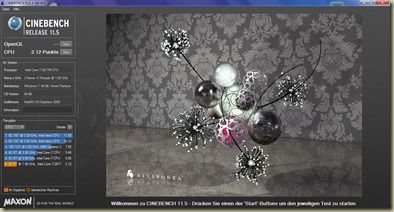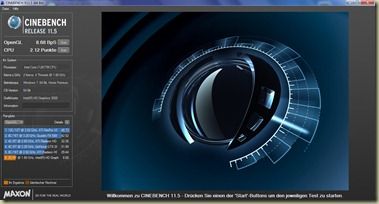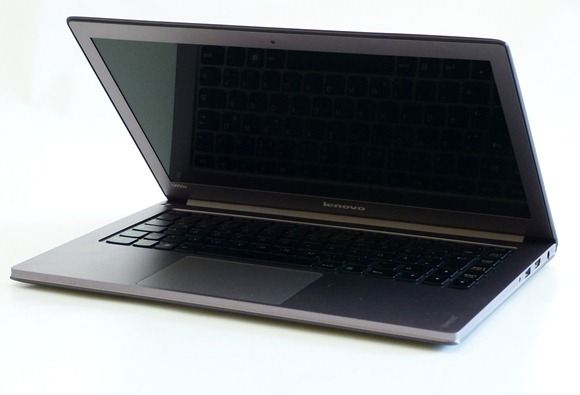Performance Testing
Running performance test suites gives you a benchmark with which to roughly compare against other devices.
PCMark7
Lenovo U300s (Core i7, 1.8Ghz) PCMark 3280. A good score that has only been beaten by the UX21 we tested, also with a Core i7 CPU.
Other scores:
- Samsung Series 5 (Core i5 1.6Ghz) PCMark: 1894 (high performance, battery power.)
- Toshiba Z830 (Core i5 1.6Ghz) PCMark7: 2885 (battery power, high-performance mode.)
- Acer Aspire S3 PCMark7:1967
- Samsung 900X1B (Core i3) PCMark7: 2508
- Asus UX21 (Core i7) PCMark7: 3358
Cinebench 11.5 CPU test (2 core)
:Lenovo U300S (Core i7): 2.12 points. The fastest we’ve tested so far.
Other Ultrabook results:
- Samsung Series 5 (Core i5 1.6Ghz Battery power, high performance mode): 1.55 points
- Toshiba Z830 (Core i51.6Ghz): 1.89 (battery power, high-performance)
- Acer Aspire S3 (Core i5): 1.63
- Samsung 900X1B (Core i3): 1.25
- ASUS UX21 (Core i7): 2.11
Cinebench OpenGL
Lenovo U300s – (Core i7, high performance mode) : 8.68
Other Ultrabook results:
-
Samsung Series 5 (Core i5 1.6Ghz): 8.03 (Battery power, high performance mode) (8.11 in second test)
-
Toshiba Z830 8.36 fps (battery power, high performance)
-
Acer Aspire S3: 7.51 fps
3DMark06
Lenovo U300S (high performance battery power): 3520 (mains power): 3611
Comparison:
- Samsung Series 5 (Core i5 Battery power – high performance mode): 3416
- Toshiba Z830 (Core i5 Battery power – high-performance mode): 3508 3D Marks (2nd-run:3518)
- Acer Aspire S3 (Core i5): 2784 3DMarks
- Samsung 900X1b (Core i3): 2373 3DMarks
- ASUS UX21 (Core i7): 3182 3DMarks
The results are some of the best we’ve seen on an Ultrabook to date. Clearly this is due to the Core i7 CPU although the Lenovo edges ahead of the UX21 / Core i7 we tested, possibly due to better thermals and higher sustained Turbo Boost.
Installed Software
We’re pleased to see that Lenovo have kept the U300s fairly clean in terms of pre-installed software although it would have been nice to see a driver update application.
Lenovo have installed their one-key recovery system, the Web Cam application and some energy management software. Intel’s WiDi and My WiFi is also installed. A time-limited demo of Absolute Data Protection software is installed.
During the tests our system was running around 82 background applications, a good figure for an out-of-the-box Windows 7 laptop.
Battery Life
For a very detailed look at battery life on the Lenovo U300s, see this report.
The Lenovo appeared to have a little issue with idle drain power and backlight drain that affected low-end usage. Here are some of the battery life figures obtained through our testing.
- Internet Radio Wifi-on battery saving mode, screen on low, 30% volume, clean + idle system) – 7 hours
- Web-based work. Wifi-on. Balanced power mode, Screen-on 50%. Chrome mix of web apps and pages – 6 hours
- Average office working scenario – Balanced power mode, office apps, network file share access, photo gallery, media player and web as above = up to 5.5hrs
- High-end CPU scenarios such as video rendering – 2.5hrs
- Full load with CPU and GPU testing software – 1.5hrs
The figures are generally OK but inly because of the relatively large battery in the U300s. We would have liked to have seen more low-end efficiency.
Heat / Noise
The Lenovo U300s is well designed in terms of heat and noise. The fan is on continuously but is only audible in the quietest of rooms. The side-firing exhaust port (left) keeps heat away from the keyboard area. As with all Ultrabooks under load, there’s airflow noise that would be annoying in a quiet room but there’s no mechanical noise.
Recovery
Recovery disks are not included but Lenovo have a One-Touch recovery system. On this U300S it doesn’t appear to be working, possibly because this is a review device. The One-Touch recovery system, when working, offers a good selection of factory and user recovery modes and the ability to burn recovery disks. The one-touch recovery button boots the system into the recovery mode without the user have to find out the magic Fn-key before the BIOS boot processes finished.
Stability and Quality
We saw no stability issues during the two-week test period and haven’t detected any weak points in the build quality. Overall the quality of the Lenovo U300s is excellent with strong build and good looking materials.
Notes made during testing
Taken direct from our notepad.
- Good clean build
- No driver update automation
- No on-screen indicators for function buttons
- Keyboard locks touchpad too long.
- Side viewing angles tight
- Fan on all time but quiet.
- Slightly sticky keys bottom left.
- Synaptics scrolling a bit jerky
Support Ultrabooknews and detailed reviews.
You’ll find a Facebook ‘Like’, Twitter, Google +1 and other buttons at the top of this article. Please take the time to promote us if you feel this review was useful. It helps us to keep standards high.
Target Customer
The name ‘Lenovo’ is associated with a business-oriented customer although the Ideapad brand is definitely not the range that business users would go to first. It does, however, retain a level of build quality and style that would appeal to a business user. For those looking for one of the most powerful Ultrabook solutions, the Core i7-based U300s here is definitely worth considering, especially given its good thermal design. The Lenovo U300s doesn’t excel in any particular area though and those expecting the best keyboard experience might want to do a test run before buying because a few stickily keys and that touch-pad lock-up could affect efficiency. It’s not for the budget-minded either so with prices dropping on many other solutions, it could end up as a premium Ultrabook for Lenovo fans.
Summary
The Lenovo U300s is a great looking all-rounder but not the best value and definitely not up there with Lenovo’s business-best. Apart from the build quality and looks which we (or at least this reviewer) found to be top-notch, there’s nothing that really sets the U300s apart from other Ultrabooks apart from the quick-charge feature. It’s light, powerful, usable and doesn’t have any hidden surprises apart from that annoying frozen touchpad which could really hamper those use any sort of applications that require lots of text-mouse switching.
In terms of value and availability, Lenovo has some scope for improvement. Prices aren’t the most competitive and availability is slightly restricted, at least in the EU and US channels we checked.
The U300s looks really stylish, is fast, and offers a great upgrade from a ‘standard’ laptop in terms of portability and availability. This isn’t the best mobile Ultrabook around and not the best value right now but it is one the best all-rounders we’ve tested and in with the Core i7 CPU, one of the most powerful.
Images
You can find a large gallery of Lenovo U300s images in the gallery hosted over at UMPCPortal.
Full Lenovo U300s specifications and information page including new articles available here.
Thanks to Lenovo UK for supplying the review device.
Pages: 1 2

















Thanks for the review!
While I too love the design of the u300s, and I suspect I would like the keyboard, the rest of the laptop is just seems average.
I do however like the idea of reversing the function keys, or at least include a Fn-Lock key. It really should be standard.
What a terrible keyboard layout! For many of us (writers included) just THIS type of keyboard layout is the worst, because the right shift key is so “neutral” (being for many a very important key) and located sort of squeezed in between the others keys and too closely located to the arrow keys. Mistypings are invited!
One much better way of arranging this part of the keyboard is to make the right shift key larger and located in a more separate fashion. And the same with the important arrow keys: Located them in a more “grouped” way (even if that makes them smaller – of course that is not optimal).
The main rationale for deciding where and how these important keys (=right shift key and arrow keys [esp. the arrow up keys]) must for the designer of the keyboard layout be to locate the keys (and especially these keys) in a way that minimize the risk of mistyping, Examples of GOOD keyboards: MacBook Air, ASUS Zenbook, and many others. (An old example of a BAD layout is the obsolete Sony Vaio P. But – given the larger footprint – this Lenovo keyboard is not much better! And this is such a shame: In the “good ol’ days”, Lenovo/IBM had so good keyboards….
I’ve been exploring for a little bit for any high quality articles or blog posts in this sort of space . Exploring in Yahoo I finally stumbled upon this web site. Reading this information So i’m satisfied to show that I’ve a very just right uncanny feeling I discovered just what I needed. I such a lot indisputably will make certain to don?t overlook this web site and provides it a look on a constant basis.